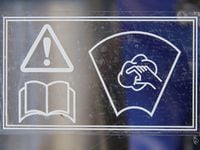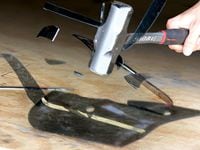The two most common plastics used to make windshields are acrylic, which goes by the trade name Lucite or Plexiglas, and polycarbonate, also known as Lexan. Despite the similar-sounding names they’re different enough to justify knowing more about them before you pick a windshield.
Acrylic is the shinier of the two and the least expensive, but it cracks or shatters easily on impact compared to polycarbonate. In any application where the windshield is meant to protect you from flying debris or where it's exposed to the same, acrylic's lower cost is offset by the likelihood of it exploding into pointy shards if it's hit hard. On the upside it's more scratch resistant than polycarbonate, so it's easier to keep looking new.
Polycarbonate is a lot tougher than acrylic. While acrylic is about eight times stronger than untempered glass, polycarbonate is about 200 times stronger. It's used in DOT-approved helmet face shields, as well as racecar windows and machine-tool safety shields. Laminated layers of polycarbonate can even be used to stop bullets, though you don't want to annoy anyone that much if all you have between you and a high-caliber argument is a motorcycle windshield. Polycarbonate is easier to scratch, but windshield manufacturers get around this by adding a protective layer of hard-coating.
Hard-coated polycarbonate is pretty much the current state of the windshield manufacturer's art. The hard-coating is getting better, too, according to National Cycle, which says its proprietary Quantum process is 10 times more scratch resistant than the original hard-coated polycarbonate and 30 times more than acrylic.
About the only thing acrylic has going for it is low cost, so unless you’re fitting a decorative fly screen to your vintage bike or adding wind deflectors to your handlebar, polycarbonate is the way to go. Its superior impact and scratch resistance is worth the extra money, and the added layer of protection from debris is priceless.












/cloudfront-us-east-1.images.arcpublishing.com/octane/VZZXJQ6U3FESFPZCBVXKFSUG4A.jpg)
/cloudfront-us-east-1.images.arcpublishing.com/octane/QCZEPHQAMRHZPLHTDJBIJVWL3M.jpg)
/cloudfront-us-east-1.images.arcpublishing.com/octane/HXOUJXQWA5HBHGRO3EMJIGFMVI.jpg)

/cloudfront-us-east-1.images.arcpublishing.com/octane/3TIWWRV4JBBOLDVGRYECVVTA7Y.jpg)
/cloudfront-us-east-1.images.arcpublishing.com/octane/KIX5O23D5NAIBGFXBN3327DKZU.jpg)
/cloudfront-us-east-1.images.arcpublishing.com/octane/7GJYDUIPXRGMTMQKN6ONYOLBOU.jpg)
/cloudfront-us-east-1.images.arcpublishing.com/octane/MUQLOVLL2ZDGFH25ILABNBXKTI.jpg)
/cloudfront-us-east-1.images.arcpublishing.com/octane/TNOU5DNE2BC57MFPMGN2EIDXAM.jpg)
/cloudfront-us-east-1.images.arcpublishing.com/octane/GTCXACQGJ5HAPDTGWUQKDEH44E.jpg)
/cloudfront-us-east-1.images.arcpublishing.com/octane/S35YGSEMEZB4BLTDJTSZPF4GLA.jpg)
/cloudfront-us-east-1.images.arcpublishing.com/octane/5UOT6HPX2JFMRJAX6EH45AR4MQ.jpg)
/cloudfront-us-east-1.images.arcpublishing.com/octane/OKWOJWAKP5EP3OACCRRWPCIX2Q.jpg)
/cloudfront-us-east-1.images.arcpublishing.com/octane/2WF3SCE3NFBQXLDNJM7KMXA45E.jpg)
/cloudfront-us-east-1.images.arcpublishing.com/octane/G4MG6OUCJNBSHIS2MVVOTPX65E.jpg)
/cloudfront-us-east-1.images.arcpublishing.com/octane/IIGGWFOTOJGB7DB6DGBXCCMTDY.jpg)
/cloudfront-us-east-1.images.arcpublishing.com/octane/QSTCM6AVEZA5JJBUXNIQ3DSOF4.jpg)
/cloudfront-us-east-1.images.arcpublishing.com/octane/U4I7G625B5DMLF2DVIJDFZVV6M.jpg)
/cloudfront-us-east-1.images.arcpublishing.com/octane/B6XD6LS6IVCQPIU6HXDJSM3FHY.jpg)
/cloudfront-us-east-1.images.arcpublishing.com/octane/ICL63FEDDRDTTMINYICCEYGMDA.jpg)
/cloudfront-us-east-1.images.arcpublishing.com/octane/FCGZHQXRBZFLBAPC5SDIQLVF4I.jpg)
/cloudfront-us-east-1.images.arcpublishing.com/octane/WNOB6LDOIFFHJKPSVIWDYUGOPM.jpg)

/cloudfront-us-east-1.images.arcpublishing.com/octane/X33NU3E525ECRHXLNUJN2FTRKI.jpg)